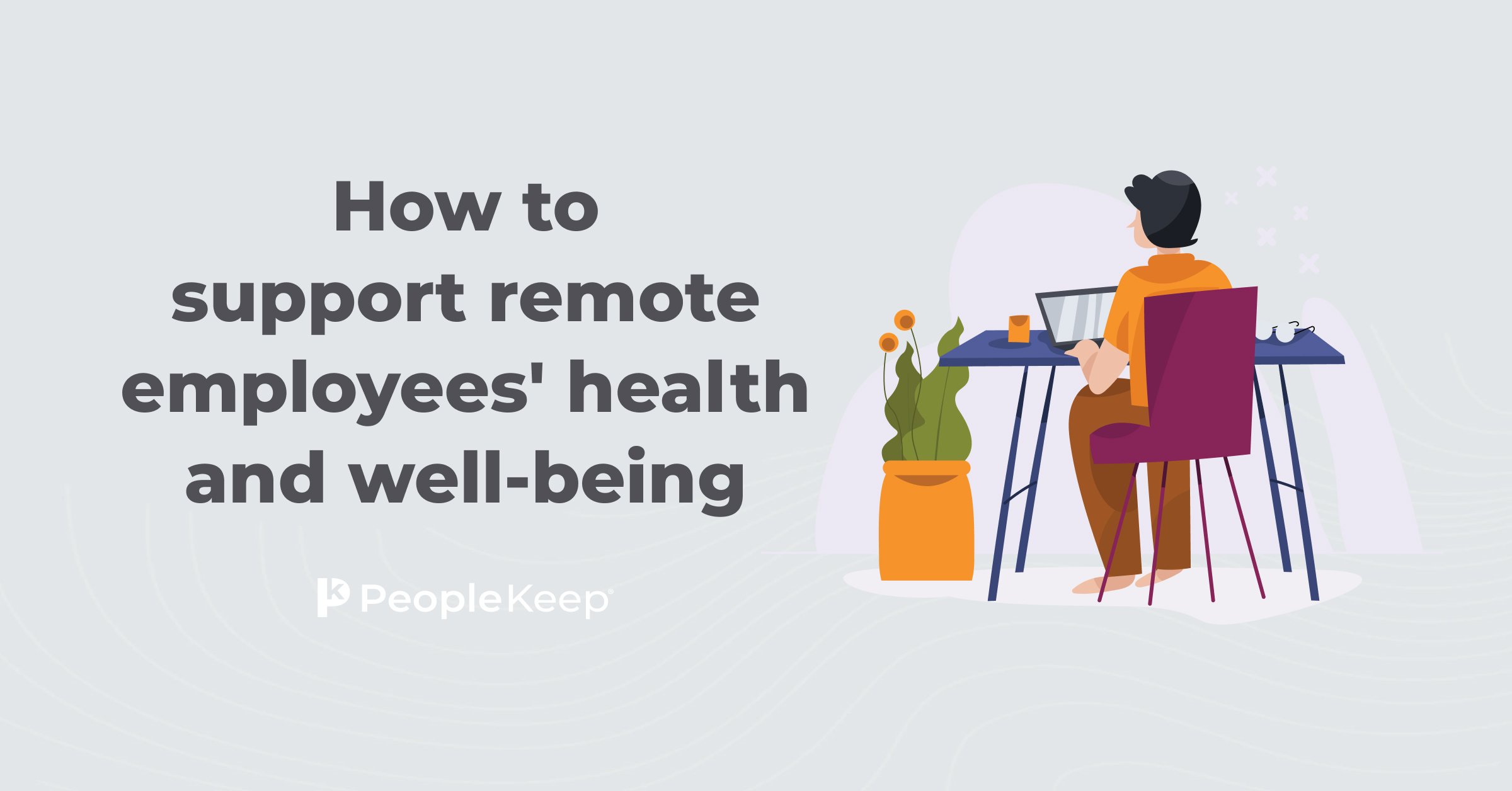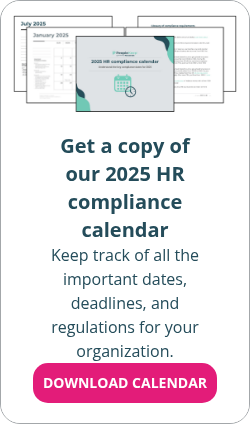How HR can support employees with disabilities
By Elizabeth Walker on February 1, 2023 at 10:55 AM
Sixty-one million adults1 in the United States live with a disability. However, many experience difficulty finding a job—even though the Americans with Disabilities Act2 (ADA) prohibits employers from discriminating against employees or candidates with disabilities.
Making sure your workplace is inclusive regarding gender and race isn’t enough these days. To open your company to a wider range of talent, HR professionals and employers must prioritize recruiting and supporting employees with disabilities.
Ensuring your workplace offers people with disabilities an equal opportunity to succeed helps you boost productivity, build a more diverse team, and become an employer of choice. But it can take time to figure out how to begin. In this blog, we’ll highlight six ways you can support employees with disabilities at your organization.
Why supporting employees with disabilities in the workplace is important
Disability inclusion goes beyond complying with legal requirements. While following the ADA’s regulations is a great starting point, there’s more you can do to support employees with disabilities. After all, disabilities aren’t uncommon, and not all are visible. You likely have employees who are physically, mentally, or emotionally impacted by disabilities every day.
An inclusive workplace gives all employees equal opportunity to succeed and grow in their careers, regardless of their potential handicaps. Disability inclusion promotes safe work environments, fair compensation for all employees, and valuing individuals for their diversity.
When you’re supportive and inclusive, you’re more likely to attract and retain great employees because they can see you’re a company that cares.
Other advantages of disability inclusion are:
- An expanded talent pool: Workers without disabilities are three times more likely to be employed than workers with disabilities. If you’re not hiring individuals with disabilities, your candidate pool is automatically reduced. Individuals with disabilities can bring unique problem-solving skills, cultures, perspectives, and life experiences to better your workplace.
- Increased productivity: A study3 found that employees with disabilities contributed to higher productivity, fewer absences, and increased customer loyalty as they tend to problem-solve with more innovation and creativity than people without disabilities.
- Higher retention: People with disabilities tend to look for stable, reliable jobs resulting in higher retention rates than individuals without disabilities. This is cost-effective for your organization as it’s cheaper to retain current employees than hire new ones.
- Greater profitability: According to Accenture4, companies with disability inclusion experience 28% higher revenue, twice the net income, and 30% higher economic profit margins over a four-year period than companies that aren’t inclusive. The same businesses were twice as likely to have higher total shareholder returns than their peer groups.
Six ways you can support employees with disabilities
Employing individuals with disabilities is not as challenging or time-consuming as many employers may think. Below are some tips you can utilize at your organization to ensure all your employees feel included in the workplace.
1. Make your hiring process more accessible
Supporting people with disabilities starts before you hire them. According to the Society for Human Resources Management (SHRM), only 25% of organizations5 have guidelines for recruiting and hiring people with disabilities. Your hiring process may need revisions to ensure it's accessible for individuals with disabilities to receive the best candidates possible.
Let’s start with your job descriptions. Avoid ableist language and requirements (such as including unnecessary physical demands) and rework your job description to focus on essential criteria instead of preferred attributes to be inclusive to all kinds of qualified workers.
You can also include information encouraging individuals with disabilities to apply, like a statement outlining your company’s commitment to disability inclusion, the accommodations and accessibility features at your workplace, or the disability organizations your company supports.
Next is your application form. Complex websites, captcha tests, and other features can be challenging for individuals with disabilities. Make sure any online documents are compatible with screen readers that read text out loud. If you’re doing in-person recruiting, bring copies of your documents in large print and braille.
Finally, ensure you're posting your open positions in places geared toward applicants with disabilities. There are various networks, like the Employer Assistance and Resource Network6 (EARN), to help you find qualified workers with disabilities. State agencies are available if you’re looking for local talent.
You can also leverage recruiting and referral programs, like the government-sponsored Workforce Recruitment Program7, to connect you with college students and recent graduates with disabilities hoping to enter the workforce.
2. Design a benefits package that supports employees with disabilities
Offering an array of benefits is vital to keeping any employee happy at your organization. However, there are some specific benefits and perks you can consider offering your employees with disabilities that may be especially advantageous.
A few supportive benefits to add to your compensation package for employees with disabilities include:
- Employee assistance programs: EAPs offer no-cost mental health counseling, referrals, and other services to employees experiencing personal or work-related challenges. Additional services can include legal and financial resources, like creating wills, powers of attorney documents, guardianships, and trusts.
- Health reimbursement arrangements (HRAs): HRAs allow employers to reimburse their employees tax-free for their health insurance premiums and qualified medical expenses. HRAs are a handy benefit for those with disabilities, especially if they have costly medical conditions or unexpected healthcare costs.
- Stipends: You can offer a variety of employee stipends to all your staff. However, wellness stipends may be the most beneficial for your employees. Wellness stipends are primarily used for physical and mental wellness needs and can encourage them to focus on their wellbeing.
- Life insurance: Obtaining life insurance can be challenging for people with disabilities, so incorporating it into your benefits package is a great perk. Basic life insurance is typically low-cost or free to the employee. You can also offer supplemental life insurance as an extra layer of protection in addition to the basic policy.
- Disability insurance: It goes without saying that disability insurance is a significant benefit to offer your employees. Short-term disability insurance typically covers six-week to six-month periods, whereas long-term disability benefits kick in once your employee’s short-term disability period ends.
- Retirement plans: Offering a 401(k) plan, matching some or all of your qualified employee contributions, can take some of the financial pressure off your employee’s shoulders. Plus, since their contributions are pre-tax, you can help them reduce their overall taxable income.
3. Create a safe and inclusive work environment
Making your work environment a safe space is critical to supporting your employees with disabilities. If they feel comfortable sharing their disability with their teammates, you can encourage empathy and provide resources to promote disability understanding and awareness.
To create a safe, inclusive space, you can:
- Make disability inclusion a company value and outline your steps towards disability inclusion in your company policy.
- Provide company training to reduce bias against people with disabilities—both subconscious and unconscious.
- Create an employee resource group for those with disabilities to use as a support system.
- Remember to provide various ways of attending ERG meetings and events for accommodation purposes.
- Develop mentoring and career growth opportunities for employees with disabilities.
- Educate all employees about the accommodations and resources available throughout your workplace.
For those that aren’t comfortable disclosing their disability, even if you’ve taken steps to create an inclusive workplace, accept their decision and don’t push. For your employees, a big part of having a safe environment is knowing your feelings are respected.
4. Prioritize accommodations and accessibility
Under the ADA, you must provide reasonable accommodations for individuals with disabilities. However, you should strive to go beyond the ADA’s minimum accommodation obligations to make your employees' lives even easier.
Some employers might not make extra accommodations at work because they’re concerned about cost. However, recent research8 found that most workplace accommodations cost nothing to make, and the rest typically costs only $500 per employee .
Even if you don’t currently have workers with visible or invisible disabilities, it’s worth the investment to make your workplace more accessible and functional for future candidates and employees.
The workplace accommodations you provide may vary depending on your employees’ needs, but they can include the following:
- Buying screen readers for computers for those with visual impairments and other assistive technology.
- Providing natural light, noise-canceling headphones, and quiet workspaces for employees with neurological conditions.
- Using a variety of communication methods for those that are deaf, blind, or simply communicate more effectively, either written or verbally.
- Allowing employees to bring service animals and emotional support animals on site.
- Providing a few designated parking spaces close to the workplace entrance for employees with disabilities.
- Incorporating elevators and ramps into your workplace instead of only stairs.
- Adding wheelchair-friendly bathrooms to promote inclusion.
Lastly, make sure you consider what constitutes reasonable accommodations and accessibility outside of the workplace. For example, if you have people who can’t drive and your area has inaccessible public transit, consider allowing them to work remotely or on a flexible schedule that accommodates their transportation restrictions.
It never hurts to be over-prepared when it comes to accommodations for employees. The cost is low, but the value is high, and your employees will appreciate you taking the time to prioritize their needs and wishes.
5. Provide training to educate your employees
Both unconscious and conscious biases tend to flourish when misconceptions are high. That’s why providing ongoing comprehensive training to educate your employees about disabilities and inclusion should be a top priority for your HR team.
Training sessions to consider at your organization include:
- A review of company policies, current accommodations and accessibilities, and what steps to take in case of various emergencies in the workplace.
- A workshop focused on breaking down conscious and unconscious bias.
- An overview of disability resources and programs at your company and within the community.
- Offering American Sign Language (ASL) classes for teams and colleagues with deaf employees.
- Mandatory leadership training for managers and supervisors on how to best support persons with disabilities.
As you’ll want to invite employees with disabilities to these events, you’ll need to ensure they’re accessible. Avoid venues with stairs and no ramps, places without easily accessible restrooms, or areas that are too small, as individuals won’t have a place to sit and rest.
Also, announce these trainings well in advance so workers requiring specific transportation needs have time to make arrangements so they can participate. If they can’t make arrangements, consider recording your trainings for virtual viewing later.
6. Gather employee input
The best way to find out what your employees with disabilities want to see from you and your workplace is by surveying them. Gathering feedback can help you discover areas for improvement, additional accommodations needed, and your employees’ engagement level.
Surveys also show your employees that you value open and honest communication and care about their opinions. This can be particularly impactful for your employees with less visible disabilities, as it may not always be clear what their needs are unless they're comfortable enough to tell you.
While you should survey all your employees, questions to include specifically for your workers with disabilities are:
- How comfortable do you feel working here?
- How would you rate our existing disability programs and training? What additional programs and training would you like to see?
- How do you feel about our disability inclusion efforts? Where would you like to see improvement?
- What additional accommodations do you need?
- What steps would you like leadership to take to make the work environment more conducive to disabled people?
- What other benefits or perks would you like added to the compensation package to support employees with disabilities better?
Once you have received the feedback, you can take the necessary steps to improve your company’s culture and work environment so your employees have everything they need to feel comfortable and perform to the best of their ability.
Conclusion
HR professionals and business leaders are obligated to provide a safe and fulfilling work experience for their employees—whether they have a disability or not. Supporting your employees with disabilities goes beyond inclusion. Promoting equal rights for all improves job performance, boosts team morale, and creates a work environment where people with disabilities can thrive.
If you want to show workers with disabilities that you care, you can start by adding various perks to your benefits package. By offering personalized benefits, like an HRA or stipend, you can better support your employees both in and out of the office. Contact us, and we’ll help take your benefits package to the next level.
3. BestBuddies
4. https://www.accenture.com/_acnmedia/pdf-89/accenture-disability-inclusion-research-report.pdf
Check out more resources
See these related articles

How to support remote employees' health and well-being
Discover strategies for supporting the health and well-being of your remote employees with this comprehensive guide. Start taking care of your team today!

What are health insurance rewards programs, and how do they impact HRAs?
In this article, we'll explain how health insurance rewards programs work and how they impact benefits like health reimbursement arrangements (HRAs).

How to hire great managers
Learn how offering health benefits can help you hire great managers. Attract top talent with competitive perks that support retention and leadership.



